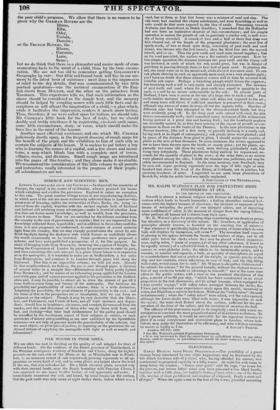MR. RALPH WATSON'S PLAN FOR PREVENTING SHIPS FOUNDERING AT SEA.
TO THE EDITOR OF THE SPECTATOR.
SIR—It is almost a national religion with Britons to delight in every in- vention which tends to benefit humanity : a feeling altogether national wel- comes with the highest honours of discovery, the inventor or improver of the means of mitigating the perils of our intrepid sailors, and of imparting some confidence of safety in the moment of danger from the raging billows, when perhaps.all human aid is distant from their view.
Mr. R. Watson's plan for preventing ships foundering at sea deserves pecu- liar attention, as a discovery of this nature. His invention, or application of principles already known, is founded on the unerring law of nature- " that whatever is specifically lighter than the quantity of water which its own bulk will displace by immersion, will swim*." The invention itself consists in placing in the spaces between the beams and timbers of ships, and in all other parts below the decks where they may be placed without inconveni- ence, safely tubes, " made of copper, (or of any other substance, if found to be equally secure,) of a cylindrical form t, terminating at each extremity by convex or semi-globular ends ; the whole to be hermetically sealed, and to contain, in number and capacity, a bulk, or quantity of atmospheric air equal to counterbalance that extra portion of the weight, or specific gravity of the ship and her contents, which otherwise, in case of leak, and the ship tilling with water, would cause her to sink." Mr. Watson is altogether disinterested: he submits his scheme " for the general benefit, without the slightest reserva- tion of any exclusive benefit or advantage to himself;" and at the same time oilers to the public notice, with a view to the practical elucidation of the plan, a model of an SO gun ship, " which has been constructed on an exact proportion to the real dimensions, and its actual tonnage, when equipped for a four months' voyage," with safety tubes arranged between the decks, &c. I have just witnessed some experiments made upon this .model, immersed in water, and filled from a valve in the bottom. Without the " safety tubes" she sank instantaneously ; when the " safety tubes" were added, and the valve opened, although the lower decks were filled with water, it was impossible to sink the vessel; the main deck floated above the surface, sufficient for the pre- servation of the lives of the sailors, and the certainty of securing the hull. The efficacy of this plan seems equal to its simplicity ; and it only wants in- vestigation to convince the most prejudiced mind of its extreme usefulness. To give it greater publicity, it would be advisable for the ingenious inventor to place it in some conspicuous and convenient place in London, where indi- viduals may judge for themselves of its efficiency, and who will then estimate • London, 9th Feb. 1829.
* See Mr. Watson's printed Explanatory Statement.
T It is not necessary to limit the experiment to cylindrical tubes, as any other figures, such as squares, or parallelograms, would be more compact, and take up less space.


















 Previous page
Previous page